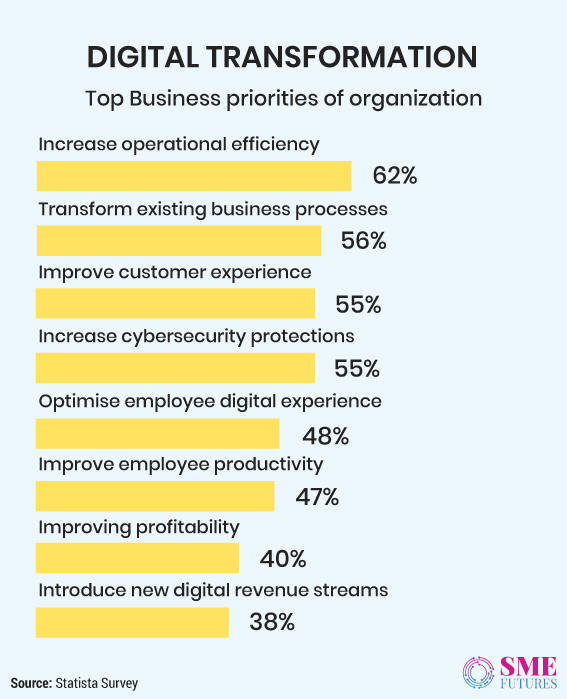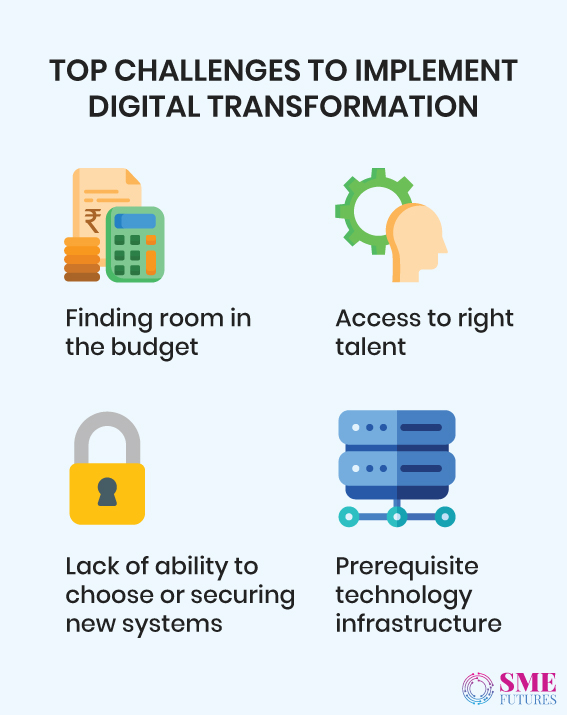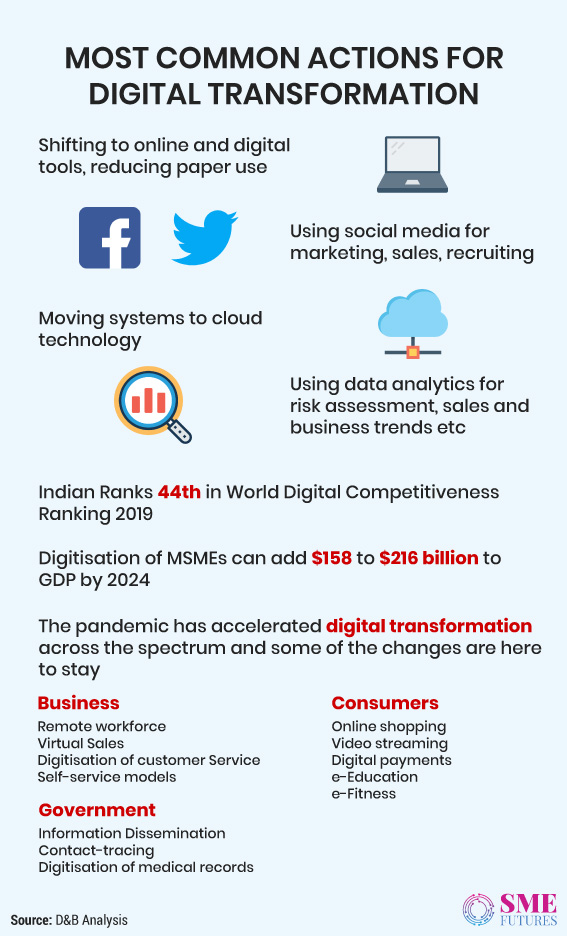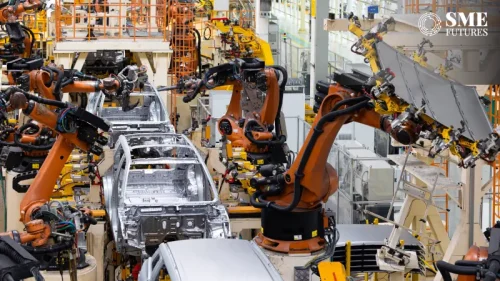Embracing the cultural and behavioral shifts that COVID-19 has introduced, Vinod Cookware, a cookware brand, is working aggressively to strengthen its existing online presence. With a completely new digital blueprint, the company wishes to transform all offline activities to digital through an omni-channel model. This plan includes improving their e-commerce website, implementing new strategies to enhance shopping experience of consumers, and introducing greater virtualization.
It is also planning to employ AI/ML tools that will automate its communication with customers and will establish supply-chain resilience. Parallelly, Vinod Cookware also aims to automate its vast offline presence which includes taking advantage of alternatives that confine in-store interactions like BOPIS (buy online and pick-up in store).
Sunil Agarwal, Director, Vinod Cookware feels that with the new normal, the company has begun exploring the right trajectory for growth. He professes, “COVID-19 has redefined businesses in India, putting the focus on online practices. This also seems to be a long-term formula for growth in new world. Thankfully, we at Vinod Cookware took digital steps before the outbreak of COVID-19. It is just accelerating the digital adoption aggressively and wisely.”
Due to the constricted movement during lockdown, their cookware manufacturing was on halt. This gave an opportunity to them to refurbish their IT infrastructure. Similarly, other small businesses are undergoing digital transformation to remain relevant and agile. For instance, iQuippo, a construction equipment sales and finance firm adopted IBM blockchain technology.
It was not only to build a platform for consumers to choose from different financial institutions (FIs) but also to negotiate through various online mediums and to provide customised solutions.
Similarly, Vanya Chandel, Founder of Forfurs which manufactures handmade pet care products from Kanpur transformed her business digitally. She created a robust catalogue with help of Prione, a joint venture between Catamaran Ventures and Amazon. It made their product listing more interactive and assisted her in advertising the products on an online marketplace. However, these are just few case studies where COVID-19 has pushed forward the digital journeys of enterprises.
Often considered as a bulwark of the economy, India’s MSME segment is one of the most potent growth engines for the Indian economy. It contributes a significant 29 per cent to GDP while generating employment and boosting overall economic activity. However, according to CRISIL research, this pandemic has impacted the sector badly with 5 per cent contraction in GDP.
Therefore, it is a watershed moment for the digital transformation of business. Arun Singh, Chief Economist at Dun & Bradstreet Global claims that the MSME sector will at least take 7 to 8 months to recover from the impact of crisis, and its recovery also depends on the extent of digital transformation. Cisco India SMB Digital Maturity Study 2020 also reveals that the digitalisation of SMES could add US$ 158 to 216 billion to India’s GDP by 2024.

Digital Transformation – An Inevitable Step
MSMEs were lagging in digital transformation even before the outbreak of pandemic in the country. As per an estimate by Zinnov Consulting, out of the 75 million Indian MSMEs, 16 to 18 million have an online presence which includes possessing a website, an online listing, or the social media presence. Furthermore, half out of 5 million domain names have a website.
On the other hand, nearly 97 per cent of mid-market firms were focused on their journey of digital transformation. They had already leveraged on newly invented techniques in IT infrastructure, applications, and processes. In addition to it, many were adopting more modern approach by experimenting with cloud, artificial intelligence, and machine learning.
COVID-19 then accelerated the digital trend and forced India Inc. to rethink about the IT infrastructure. Afterwards, small firms were bound to accept the trend. A June survey by Endurance International Group revealed some interesting findings about the trend.
According to the survey, approximately 30 per cent of MSMEs started a business website or an e-commerce functionality during the lockdown. More than 50 per cent of the MSMEs surveyed had embraced video conferencing tools and WhatsApp to keep business running during these turbulent times.
The findings also revealed that MSMEs are seeking support from the government to wade through this crisis. More than 50 per cent of MSMEs expect the government to offer tax discounts or exemptions, followed by 36 per cent of MSMEs which are asking for loans at zero interest or cheaper rates.
Manish Dalal, SVP & GM, Endurance Group – APAC opines, “COVID-19 has forced everyone to rethink about our daily lives. In response to the lockdown, MSMEs who could embrace digital presence were able to retain some semblance of normality and continued to serve or engage with their customers.”
Small businesses have been constantly grappling with drastically reduced liquidity, disrupted supply chains, and lending challenges. To bounce back, they need to re-imagine their business models and identify their place and role in the new normal. Hence, most small businesses have realised that going digital is critical and hence they are willing to disrupt themselves.
Some Kirana stores have also quickly transformed into fulfillment centers for e-grocery portals to keep the business going and to fulfill demands arising around their neighborhood. For instance, Kirana shop owner Chakrapani adopted digital services to cater the growing needs in Hyderabad when witnessed a major footfall during lockdown. He also started using mobile wallets to accept payment, while maintaining a digital inventory for stock. A Hyderabad based fintech company helped them in this journey of transformation.
Furthermore, trends like shopping online and contactless delivery has also gained acceptance among consumers. Hence, it is an opportune time for SMEs or start-ups to not only manufacture products locally but also to sell them through several online retail portals to increase the reach of their products.

Efforts by Government and Technology Companies
To chart the course for recovery for SMBs in post-COVID-19 era, government, technology companies, and small and midsize businesses (SMBs) are working together. The government has announced several schemes under equity packages to tide over the crisis.
The equity support that the government has announced should be invested by the SMBs in buying new inventory as well as in adopting technology solutions to make them disaster-proof. With the definition of SMB being revised by the government, more businesses will now be able to avail those benefits. This would further provide impetus for micro-businesses to grow.
SMBs also need to leverage digital technologies to facilitate increased discoverability through online presence and digital storefronts. This would keep customers updated about their products and services through regular digital updates. Also, common horizontal functions such as finance, accounting, or payroll can be made efficient by using automation-based solutions.
On the other hand, government bodies and technology firms are collaborating to provide cutting edge solutions to the companies for continuing their business. For instance, Zoho has collaborated with NASSCOM Foundation for the Big Tech Program. Under this scheme, the Chennai based software company is equipping non-profit businesses with necessary technology tools.
Talking about this, Hyther Nizam, VP Product Management, Zoho Corp. says, “While nonprofit leaders acknowledge that technology integration can help in increasing stakeholder engagement, and scaling-up operations, the mere cost and effort involved may prevent many from embracing the change.”
He further adds, “By working together with NASSCOM Foundation and TechSoup, we aim to provide NPOs with easier access to cost-effective technologies that encourage them to turn their operations digital and hence in achieving better results. We will continue to introduce similar technology programmes that contribute to transformational change.”
Businesses are now migrating rapidly to cloud infrastructure for digital transformation. According to the IDC Semiannual Public Cloud Services Tracker – Forecast 2019H2, the public cloud services market in India is likely to reach $7.1 billion in 2024. It is expected to rise at a CAGR of 20.3 per cent from $3.4 billion in 2020. Viewing this as an opportunity, Airtel has collaborated with AWS to deliver innovative cloud solutions to MSMEs in India.
Harmeen Mehta, CIO and Head – Cloud and Security Business, Bharti Airtel claims, “Our endeavour is to enable enterprise customers to stay focused on their core businesses. During this, we will drive end-to-end digital transformation for them. As part of their cloud adoption journey, enterprises are looking for agility, faster migration from legacy systems, and associations with trusted partners who have the experience and depth in doing this.”
With increased awareness about the importance of a robust IT framework, IBM India is also witnessing a spike in interest by small businesses in automating and transforming their processes digitally. IBM India helped renowned dairy brand, Mother Dairy to enable work from home for about 500 employees and ensured 100 per cent monitoring of their data centre.
Another company FSS (Financial Software and Systems), a processor and payment tech provider that make MSMEs digitally self-reliant has launched a cost-efficient payment acceptance tool, called EmBark. This is for acquiring banks and payment aggregators to facilitate digital inclusion for MSMEs. The solution also offers consumers omnichannel capabilities.
Commenting on it, Sandeep Gomes, Global Business Head Acquiring FSS, states, “The digital wave is reinventing the MSME marketplace. EmBark offers industry players a real opportunity to profitably tap the underserved MSME segment by adopting ecosystem models to create a ubiquitous payment acceptance network. It also lets in them achieving service differentiation on the strength of innovative and superior business models.”
Prione which support firms in a variety of services such as product cataloguing, warehousing, digital payments etc is witnessing surge in queries from small businesses. Commenting on Prione’s role, Sandeep Varaganti, MD and CEO, Prione says, “As the world witnesses a paradigm shift in business models, SMBs should be educated about the power of e-commerce and upskill themselves accordingly. Especially in these times, SMBs will have to invest in online capabilities to ensure business continuity and succeed.”
Similarly, a Bengaluru based digital agency named Bubble Network has changed the business models for numerous offline fashion brands and agro businesses. Sahaan Suman K, CEO of the agency admits that demand from the SME market to either pivot their existing businesses online or diversify into a new segment digitally has increased.
He confesses, “Shardha Ponnappa and RK Couture are few offline fashion brands with majority of revenue coming from their boutiques. With the COVID-19 shift, they incurred huge operational costs with a drastic dip in sales. With Bubble Network on board and the right digital tools such as Google Ads, they were able to almost meet 70 per cent of their offline revenue online.”

“We have also helped agro-businesses with online set-ups, F&B businesses with media buying strategies for their food delivery services, B2B establishments with SEO and SEM to generate leads and so on. Cost of digital set up (website, landing pages, Google business and social) and CPA (cost per customer acquisition) is far more economical which makes it easier for MSMEs to capitalize,” he adds.
As businesses aim to expand their reach on digital platforms, it is important to speak global language of business and be visible on internationally used platforms. On this front, GS1 India is playing crucial role in bridging the physical and digital worlds of retail.
S Swaminathan, Chief Operating Officer, GS1 India tells that supply chains here are stretched to their limit in order to keep store shelves filled with food and hygiene products. Therefore, GS1 feels an enormous responsibility to bring renewed value to the industry. It is particularly meant for small businesses to automate their processes and to bring supply-chain efficiency.
He proclaims, “With ubiquitous ISO-endorsed GS1 barcode numbers, products and supplies get uniquely identified to reach their destinations with accurate data. These barcode numbers also help manufacturers in selling their products through multiple retail chains and online marketplaces by identifying each product unambiguously.”
The use of GS1 standards facilitate supply chain visibility and thus enable counterfeit detection and product authentication. It also makes traceability, product recall, and real-time stock monitoring hassle-free. Furthermore, GS1 barcode numbers when used on product webpages enhance the visibility of pages on Google leading to more clicks.
On global front, Al Shams Agro Group in Egypt and Chipotle Mexican Grill have set up GS1 standards-based traceability systems. In India, GS1 standards are being used by several government departments to enable authentication of documents such as skill certificates, trade licenses, academic certificates etc.
This also includes lab certificates issued by NABL, training certificates issued by CBSE, and birth and death certificate issued by NDMC. Delhi Excise also uses GS1 standards for counterfeit detection. GS1 healthcare has recently launched new solution, Finder Tool to help healthcare stakeholders to find relevant information on programmes of GS1 member organisations and active solution partners worldwide.
Widespread Challenges in Implementation
According to Harvard Business Review Report of 2018, around $1.3 trillion were spent on digital transformation globally. But when initiatives didn’t meet their goals, an estimated $900 billion was wasted. This indicates that most companies attempted to transform themselves digitally but lacked an understanding to implement the change.
The primary hurdles for SMBs in their digital transformation efforts are absence of digital skills, access to talent, and prerequisite technology infrastructure. To tackle the challenge of talent, companies have started providing training to students. For instance, Cisco India trained more than 182,000 students across India in FY20 under umbrella of their Networking Academy.
Furthermore, consumers also lack ability to choose the right platform. According to Suman K, lack of digital awareness is the biggest hassle that owners of small businesses face. For example, websites can be built on platforms such as Shopify, Wordpress, HTML etc and there is no comparison as each one caters to a very specific need.
He adds, “In my view, the cost per customer acquisition in majority of the industries is lower online. The problem small businesses face today is the ability to choose the right digital partner or agency. Another hassle is using the right digital strategy and tools which is appropriate for a specific business or financial position. Hence, the lack of digital awareness is the biggest problem small businesses owners’ face.”
Despite the challenges, SMEs are moving ahead in their digital journey. According to a study of Cisco India, 16 per cent of SMBs in the Asia Pacific region have now reached advanced digital maturity stages (3 and 4), compared to 11 per cent in 2019. Slightly more than half of SMBs have embraced digitalisation to become digital observers (stage 2). The report also states that only 31 per cent of SMBs have made very few efforts to transform digitally (stage 1).
Path Ahead for Reforms
SMBs that are more digitally mature enjoy enhanced benefits in terms of revenue and productivity as compared to those which have an indifferent approach towards digitalization. Cisco India in its survey states that 68 per cent of Indian SMBs seek digital transformation to introduce new products and services, differentiate themselves from the competition, and grow.
Out of this, 60 per cent recognise that competition is transforming, and they must be abreast with it. Also, 50 per cent seek digital transformation due to the demand of customers. The results of the study also show that the top technology investment for SMBs in India (16 percent) is for cloud technologies. It is followed by the security upgrade (13 percent), and lastly with IT infrastructure software (12 percent).
Once effectively implemented, the digital transformation can lead to business remodeling which can further drive sustained and long-term value for the company. It can also empower stakeholders by an impactful redressal of needs and priorities of employees, consumers, partners, regulatory bodies, and society at large.
It can also lead to transformation of systems by creating new collaborations and value-creation models across ecosystems to address global challenges. Further, COVID-19 has created a pressing need for business leaders to consciously shape a new ‘business normal’ that delivers inclusive and sustainable value for all stakeholders.
However, it is certain that with the course of time, it is possible that no one will be speaking of digital transformation in future because the term will be whole-heartedly embraced. Non-digital businesses will become obsolete in the new normal and surviving businesses will have to embrace digital transformation in order to evolve and thereby recover.











